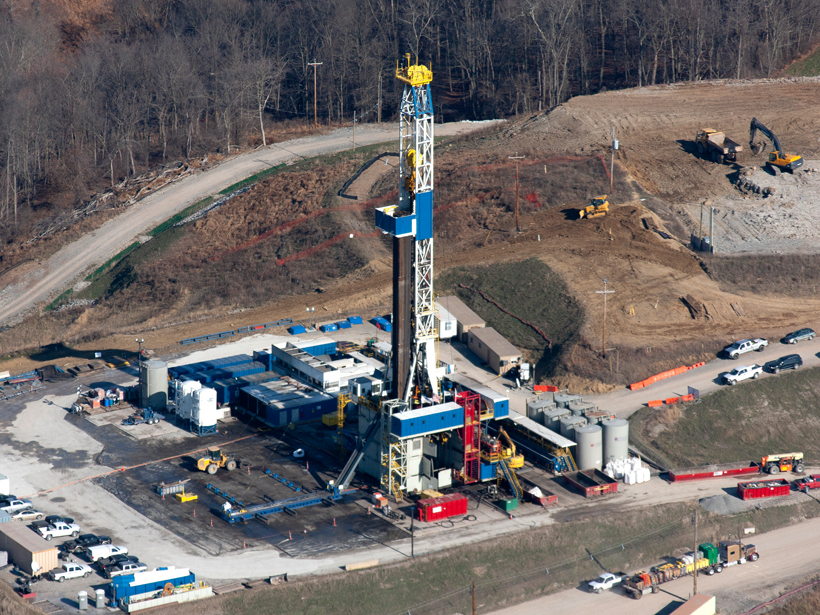Natural gas accounts for more than a third of the energy produced and consumed in the United States. Its primary selling point? A supposed ecological advantage over coal and other fossil fuels. However, the short- and long-term effects of hydraulic fracturing (fracking, a type of natural gas extraction) on local communities have never really been explored fully by the scientific community.
Recently, however, researchers from Carnegie Mellon University, Princeton University, and Stanford University released a comprehensive study on the environmental, social, and economic impacts of industrial fracking on the Appalachian Basin.
They focused on three factors: premature deaths caused by air pollution as a direct result of drilling and fracking operations, long-term impact on regional climate, and new jobs produced because of the expansion of the local energy industry. This is what they found.
Air Quality
Each fracking operation requires a huge number of vehicles and construction machines. These machines, in turn, contribute to the emission of particulate matter that is 2.5 micrometers or smaller (PM2.5), tiny particles of dust and air pollutants that can, when inhaled, trigger chronic respiratory problems like asthma and bronchitis.
“These emissions stem from both upstream processes (extraction) and downstream consumption and final use (combustion for heat and power),” said Nicholas Muller, a coauthor of the study and an associate professor of economics at Carnegie Mellon in Pittsburgh, Pa. According to Muller, anywhere from 1,200 to 4,600 people in Appalachia died as a result of this type of air pollution between 2004 and 2016.
Climate
Particulate matter isn’t the only threat to air quality associated with the fracking industry. Greenhouse gases like methane and carbon dioxide, as well as toxic gases like ozone and benzene, are produced regularly by fracking activities. Greenhouse gases, released at various stages of energy production and consumption, degrade air quality and contribute to global warming.
The new study calculates that the natural gas industry in Appalachia contributed 1,502 million tons of carbon dioxide emissions in 2016—more than the carbon emissions associated with the coal industry. Researchers suggest it would take anywhere from $12 billion to $94 billion to undo the damage fracking caused to the world climate between 2004 and 2016.
“The study’s findings do not refute claims that natural gas is a viable ‘bridge fuel’ to move the world onto a more sustainable energy path,” said Paul Ferraro of Johns Hopkins University’s Carey Business School in Baltimore, Md. Ferraro was not involved with the new research.
Employment
The study estimates that the shale gas boom contributed to employment worth 469,000 job-years, yielding a total income of between $8 billion and $33 billion in the region.
These figures represent not only the impact within the natural gas sector but also its spillover effects.
A Clean Way Out
The study doesn’t limit itself to analyzing the health, climate, and social costs of fracking. By comparing the damage done to human health and climate to the positive impact of the natural gas sector on the local economy, researchers calculated an energy tax that they say can help provide a proper check to the uncontrolled growth of the industry.
Instead of the current rate of $0.08 per thousand cubic feet (MCF), the coauthors recommend raising the tax for energy production using natural gas to $2/MCF. The authors emphasized that such a levy would have to be considered only with similar policies on other energy sources, including renewables.
“The study does a nice job of highlighting the extent to which natural gas, like all fossil fuels, is underpriced.”
Muller also recommended keeping extraction activities far from dense population centers and reducing or capturing combustion emissions downstream as other necessary steps to creating a more sustainable energy industry.
“The study does a nice job of highlighting the extent to which natural gas, like all fossil fuels, is underpriced,” says Ferraro. “Pollution taxes are the most cost-effective way to reduce pollution and encourage innovation. But these taxes need to be applied to all sources of pollution. Applying them only to natural gas could have a perverse effect of making pollution worse if it induces markets to switch to dirtier sources of energy.”
The study was published in Nature Sustainability in December 2019.
—Ritoban Mukherjee (@kosmodrone), Science Writer
9 March 2020: This article has been updated to correct the amount of carbon emissions in Appalachia in 2016.
Citation:
Mukherjee, R. (2020), How death and disaster followed the shale gas boom in Appalachia, Eos, 101, https://doi.org/10.1029/2020EO140793. Published on 27 February 2020.
Text © 2020. The authors. CC BY-NC-ND 3.0
Except where otherwise noted, images are subject to copyright. Any reuse without express permission from the copyright owner is prohibited.

